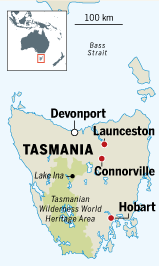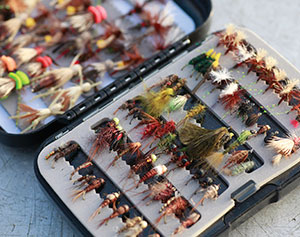Fly-fishing: the lure of Tasmania

Simply sign up to the Life & Arts myFT Digest -- delivered directly to your inbox.
One hundred and fifty years ago this weekend, 300 tiny trout hatched into a pond beside Tasmania’s Plenty river. Their lives had begun on the other side of the world in the tributaries of the Thames; their birth marked the end of one long journey, and the start of another.
These were Australia’s first trout, shipped from the UK, after years of failed attempts, thanks to the ingenuity of Sir James Arndell Youl. He had devised a way of packing the eggs in moss and ice, the cold slowing their development during the 12,000-mile journey. The 300 were the only survivors from 30,000 eggs packed in England but within five years they had swum their way throughout Tasmania’s water network.
A century and a half later, I have followed the trout from London to Tasmania, a 38-hour journey that has brought me to Lake Ina on the edge of the Tasmanian Wilderness, 1.5m hectares of Unesco-recognised forests, mountains, lakes and rivers.
Fish don’t have ears but my guide is whispering urgently as we “stalk” a wild trout, bending low to try to prevent our shadows from spooking it as it “rises”, surface feeding on newly hatched mayflies. Can I edge close enough to attempt a cast or will it glimpse my silhouette and dart for deeper water?
I’m here, like a small but growing number of anglers, because Youl’s 300 trout have thrived, turning Tasmania into what experts rate as one of the world’s top fly-fishing destinations. Partly it’s to do with the abundance of crystal clear lakes and rivers and the scarcity of other anglers, partly it’s that the trout here are wild rather than being supplemented by stock from hatcheries. “Wild fish are much more alert and challenging to catch because they haven’t been bred in captivity and hand fed,” says Greg French, author of Trout Waters of Tasmania, the bible of local fishing.
The island has been overshadowed as a fly-fishing destination by New Zealand but could become better known thanks to the introduction of package tours timed to coincide with the 150th anniversary. Tasmanian Odyssey, a UK-based company, is working with Trout Guides and Lodges Tasmania, an association of local guides and accommodation, to create and market trout fishing packages to the international market. “The geography hasn’t helped but our fishing has never been well promoted abroad before,” says Roger Butler, the association’s president. “We sold 27,000 licences last year and less than 300 were to foreign anglers.”

Even if the packages prove popular, visiting fishermen are unlikely to have to share their stretch of water. Only 500,000 people live in Tasmania, an island the size of Ireland, and more than half of them live in and around the capital, Hobart, in the south.
Back on Lake Ina, I see countless trout but my skills let me down time and again. I hook the bank with monotonous regularity until, slowly, my back cast improves. With the help of Daniel Hackett, my guide, by the end of the day I’m able to load the rod up with line behind me, then swiftly propel it forward with a whipping motion. Hackett operates RiverFly Wilderness Huts, a group of four eco-huts a 20-minute walk from the lake over spongy cushions of rare lichen. As the day wears on, the fish become more active but still I can’t persuade any of them to take my fly and I return to camp with an empty net and tales of the one that got away.

The following day I transfer to the lowland river network, south of Launceston, to try fishing alongside Butler, who runs Red Tag Trout Tours. I’m staying at Somercotes, a fortified colonial farmstead near the town of Ross, in one of four self-catering cottages – among the names in the guest book is that of comedian Billy Connolly, who Butler guided in 2010.
After brushing up on my casting in the garden we head for Lake River, near Connorville, a sheep and cattle farm where the Queen and Prince Philip stayed in 1954. As I pull on my boots and waders, Butler explains the best time of day to fish. “Late morning to late afternoon is when the fish are most active. That’s when mayfly, dragonfly and stonefly nymphs come to the surface, dry their wings in the heat and fly away for the first time.”
Tasmanian rivers aren’t manicured to provide easy access for fishermen, so I tumble down the bank and wade into waist-high water. It’s 11am and the surface is abuzz with activity – midges, enormous dragonflies and water boatmen are hard at work, oblivious to the trout lurking below. And there are plenty, kissing the surface all around me.
There’s less chance of snagging my hook fishing from the middle of the river but when the first fish does take my fly, I realise nobody has taught me what to do next. Pulling hard on the line, I stumble backwards and only just stop myself falling over. The fish has gone and the fly with it. We move upstream and try again.

It doesn’t take long before another bite bends the shaft of the graphite rod. This time I raise the line slowly and the fish is hooked. Butler barks instructions from the shore as I let the fish run with extra line from my reel, then wind him in slowly to a waiting net. It’s a 2lb brown trout, marked with yellow spots and fighting fit – a thrilling sight for me, even if a relative minnow compared with some trout caught here (the Tasmanian record stands at 29lb).
Butler asks whether I want to take my first fish home for supper but I know there is casserole waiting and, besides, it’s so beautiful that I decide to let it go. Later I catch a second, prompting more elation, before the sun sets and we head back to Somercotes.
That night a possum crashes on to my roof and something snuffles around outside the bedroom window. I drift off to sleep, content at having caught my first fish, even though I had to travel to the other side of the world to do so. With Butler’s help and a little practice, I’m sure I could hook plenty more.
——————————————-
Details
Jeremy Taylor was a guest of Tourism Australia (australia.com) and Trout Guides and Lodges Tasmania (troutguidestasmania.com.au). Tasmanian Odyssey (tasmanianodyssey.com) offers a week’s guided fly-fishing holiday with RiverFly Wilderness Huts (riverfly.com.au) and Red Tag Trout Tours (redtagtrout.com.au) from £2,975, including accommodation, transfers, most meals, tuition and equipment. Melbourne to Tasmania flights start from £110 return with Virgin Australia
Comments